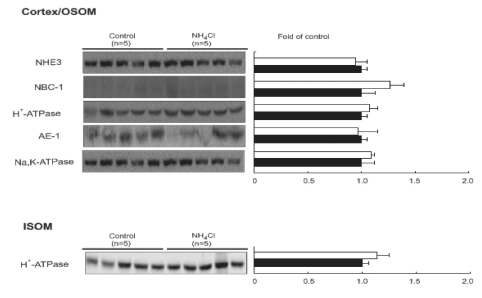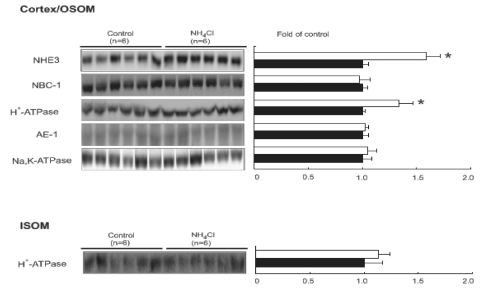Korean J Physiol Pharmacol.
2012 Apr;16(2):91-95. 10.4196/kjpp.2012.16.2.91.
Altered Regulation of Renal Acid Base Transporters in Response to Ammonium Chloride Loading in Rats
- Affiliations
-
- 1Department of Physiology, Chonnam National University Medical School, Gwangju 501-757, Korea.
- 2Department of Internal Medicine, Chonnam National University Medical School, Gwangju 501-757, Korea. skimw@chonnam.ac.kr
- 3Department of Physiology, Chonbuk National University Medical School, Jeonju 561-712, Korea.
- KMID: 2071753
- DOI: http://doi.org/10.4196/kjpp.2012.16.2.91
Abstract
- The role of the kidney in combating metabolic acidosis has been a subject of considerable interest for many years. The present study was aimed to determine whether there is an altered regulation of renal acid base transporters in acute and chronic acid loading. Male Sprague-Dawley rats were used. Metabolic acidosis was induced by administration of NH4Cl for 2 days (acute) and for 7days (chronic). The serum and urinary pH and bicarbonate were measured. The protein expression of renal acid base transporters [type 3 Na+/H+ exchanger (NHE3), type 1 Na+/HCO3- cotransporter (NBC1), Na-K+ ATPase, H(+)-ATPase, anion exchanger-1 (AE-1)] was measured by semiquantitative immunoblotting. Serum bicarbonate and pH were decreased in acute acid loading rats compared with controls. Accordingly, urinary pH decreased. The protein expression of NHE3, H(+)-ATPase, AE-1 and NBC1 was not changed. In chronic acid loading rats, serum bicarbonate and pH were not changed, while urinary pH was decreased compared with controls. The protein expression of NHE3, H(+)-ATPase was increased in the renal cortex of chronic acid loading rats. These results suggest that unaltered expression of acid transporters combined with acute acid loading may contribute to the development of acidosis. The subsequent increased expression of NHE3, H(+)-ATPase in the kidney may play a role in promoting acid excretion in the later stage of acid loading, which counteract the development of metabolic acidosis.
MeSH Terms
-
Acidosis
Adenosine Triphosphatases
Ammonium Chloride
Animals
Humans
Hydrogen-Ion Concentration
Immunoblotting
Kidney
Male
Proton-Translocating ATPases
Quaternary Ammonium Compounds
Rats
Rats, Sprague-Dawley
Sodium-Hydrogen Antiporter
Adenosine Triphosphatases
Ammonium Chloride
Proton-Translocating ATPases
Quaternary Ammonium Compounds
Sodium-Hydrogen Antiporter
Figure
Reference
-
1. Wagner CA, Devuyst O, Bourgeois S, Mohebbi N. Regulated acid-base transport in the collecting duct. Pflugers Arch. 2009; 458:137–156. PMID: 19277700.
Article2. Curthoys NP, Gstraunthaler G. Mechanism of increased renal gene expression during metabolic acidosis. Am J Physiol Renal Physiol. 2001; 281:F381–F390. PMID: 11502586.
Article3. Biemesderfer D, Pizzonia J, Abu-Alfa A, Exner M, Reilly R, Igarashi P, Aronson PS. NHE3: a Na+/H+ exchanger isoform of renal brush border. Am J Physiol. 1993; 265:F736–F742. PMID: 8238556.4. Yoshitomi K, Burckhardt BC, Frömter E. Rheogenic sodium-bicarbonate cotransport in the peritubular cell membrane of rat renal proximal tubule. Pflugers Arch. 1985; 405:360–366. PMID: 3936018.
Article5. Alper SL, Natale J, Gluck S, Lodish HF, Brown D. Subtypes of intercalated cells in rat kidney collecting duct defined by antibodies against erythroid band 3 and renal vacuolar H+-ATPase. Proc Natl Acad Sci USA. 1989; 86:5429–5433. PMID: 2526338.6. Wall SM. Recent advances in our understanding of intercalated cells. Curr Opin Nephrol Hypertens. 2005; 14:480–484. PMID: 16046908.
Article7. Kim YH, Kwon TH, Frische S, Kim J, Tisher CC, Madsen KM, Nielsen S. Immunocytochemical localization of pendrin in intercalated cell subtypes in rat and mouse kidney. Am J Physiol Renal Physiol. 2002; 283:F744–F754. PMID: 12217866.8. Tizianello A, Deferrari G, Garibotto G, Robaudo C, Acquarone N, Ghiggeri GM. Renal ammoniagenesis in an early stage of metabolic acidosis in man. J Clin Invest. 1982; 69:240–250. PMID: 7054241.
Article9. Nowik M, Picard N, Stange G, Capuano P, Tenenhouse HS, Biber J, Murer H, Wagner CA. Renal phosphaturia during metabolic acidosis revisited: molecular mechanisms for decreased renal phosphate reabsorption. Pflugers Arch. 2008; 457:539–549. PMID: 18535837.
Article10. Goldstein L, Boylan JM, Schröck H. Adaptation of renal ammonia production in the diabetic ketoacidotic rat. Kidney Int. 1980; 17:57–65. PMID: 6768921.
Article11. Kim GH, Martin SW, Fernández-Llama P, Masilamani S, Packer RK, Knepper MA. Long-term regulation of renal Na-dependent cotransporters and ENaC: response to altered acid-base intake. Am J Physiol Renal Physiol. 2000; 279:F459–F467. PMID: 10966925.
Article12. Bae EH, Kim IJ, Ma SK, Lee JU, Kim SW. Altered regulation of renal nitric oxide and atrial natriuretic peptide systems in lipopolysaccharide-induced kidney injury. Korean J Physiol Pharmacol. 2011; 15:273–277. PMID: 22128259.
Article13. Aruga S, Wehrli S, Kaissling B, Moe OW, Preisig PA, Pajor AM, Alpern RJ. Chronic metabolic acidosis increases NaDC-1 mRNA and protein abundance in rat kidney. Kidney Int. 2000; 58:206–215. PMID: 10886565.
Article14. Hafner P, Grimaldi R, Capuano P, Capasso G, Wagner CA. Pendrin in the mouse kidney is primarily regulated by Cl-excretion but also by systemic metabolic acidosis. Am J Physiol Cell Physiol. 2008; 295:C1658–C1667. PMID: 18971389.
Article15. Nowik M, Lecca MR, Velic A, Rehrauer H, Brändli AW, Wagner CA. Genome-wide gene expression profiling reveals renal genes regulated during metabolic acidosis. Physiol Genomics. 2008; 32:322–334. PMID: 18056784.
Article16. Bobulescu IA, Moe OW. Na+/H+ exchangers in renal regulation of acid-base balance. Semin Nephrol. 2006; 26:334–344. PMID: 17071327.17. Orlowski J, Kandasamy RA, Shull GE. Molecular cloning of putative members of the Na/H exchanger gene family. cDNA cloning, deduced amino acid sequence, and mRNA tissue expression of the rat Na/H exchanger NHE-1 and two structurally related proteins. J Biol Chem. 1992; 267:9331–9339. PMID: 1577762.
Article18. Tse CM, Brant SR, Walker MS, Pouyssegur J, Donowitz M. Cloning and sequencing of a rabbit cDNA encoding an intestinal and kidney-specific Na+/H+ exchanger isoform (NHE-3). J Biol Chem. 1992; 267:9340–9346. PMID: 1374392.19. Ambühl PM, Amemiya M, Danczkay M, Lötscher M, Kaissling B, Moe OW, Preisig PA, Alpern RJ. Chronic metabolic acidosis increases NHE3 protein abundance in rat kidney. Am J Physiol. 1996; 271:F917–F925. PMID: 8898023.20. Burnham CE, Flagella M, Wang Z, Amlal H, Shull GE, Soleimani M. Cloning, renal distribution, and regulation of the rat Na+-HCO3- cotransporter. Am J Physiol. 1998; 274:F1119–F1126. PMID: 9841505.21. Gross E, Hopfer U. Activity and stoichiometry of Na+:HCO3- cotransport in immortalized renal proximal tubule cells. J Membr Biol. 1996; 152:245–252. PMID: 8672086.22. Romero MF, Boron WF. Electrogenic Na+/HCO3- cotransporters: cloning and physiology. Annu Rev Physiol. 1999; 61:699–723. PMID: 10099707.23. Kwon TH, Fulton C, Wang W, Kurtz I, Frøkiaer J, Aalkjaer C, Nielsen S. Chronic metabolic acidosis upregulates rat kidney Na-HCO cotransporters NBCn1 and NBC3 but not NBC1. Am J Physiol Renal Physiol. 2002; 282:F341–F351. PMID: 11788449.24. Huber S, Asan E, Jöns T, Kerscher C, Püschel B, Drenckhahn D. Expression of rat kidney anion exchanger 1 in type A intercalated cells in metabolic acidosis and alkalosis. Am J Physiol. 1999; 277:F841–F849. PMID: 10600930.25. Purkerson JM, Tsuruoka S, Suter DZ, Nakamori A, Schwartz GJ. Adaptation to metabolic acidosis and its recovery are associated with changes in anion exchanger distribution and expression in the cortical collecting duct. Kidney Int. 2010; 78:993–1005. PMID: 20592712.
Article26. Ambühl PM, Zajicek HK, Wang H, Puttaparthi K, Levi M. Regulation of renal phosphate transport by acute and chronic metabolic acidosis in the rat. Kidney Int. 1998; 53:1288–1298. PMID: 9573544.
Article
- Full Text Links
- Actions
-
Cited
- CITED
-
- Close
- Share
- Similar articles
-
- Renal Handling of Ammonium and Acid Base Regulation
- Renal Tubular Acidosis in Cadmium-Intoxicated Rats
- Altered Renal Expression of Acid-base Transporters in Rats with Glycerol-induced Tubular Injury
- Altered Regulation of Renal Sodium Transporters in Salt-Sensitive Hypertensive Rats Induced by Uninephrectomy
- Alkali Therapy Attenuates the Progression of Kidney Injury via Na/H Exchanger Inhibition in 5/6 Nephrectomized Rats



